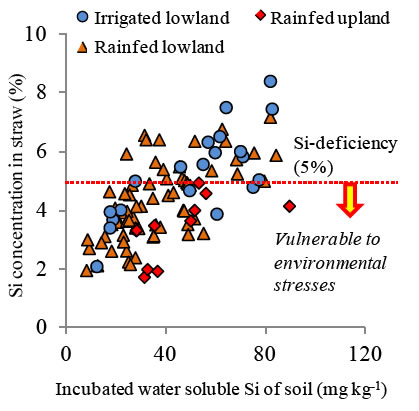Limited Si-nutrient status of rice plants in relation to plant-available Si of soils, nitrogen fertilizer application, and rice-growing environment across Sub-Saharan Africa
Description
Rice is a specific silica-accumulator among higher plants. The Si in rice enhances resistance to biotic and abiotic stresses. The booming demand for rice in Sub-Saharan Africa (SSA) requires rapid increases in rice production, and hence more Si supply will be needed from soils, irrigation water, and external inputs. However, there have been no Si management practices or any extensive surveys conducted to identify the nature and magnitude of the problems with plant Si nutrient status and Si availability in the soils for rice production in SSA. Therefore, an extensive survey is conducted for evaluating variability of Si concentration in rice straw in relation to soil properties, fertilizer management practices, and rice-growing environments across a wide range of local farmers’ fields in SSA.
The Si concentration in straw ranges 1.7-8.4% among the harvest samples at 99 local farmers’ fields in Benin, Ghana, Guinea, Kenya, Madagascar, Mozambique, and Nigeria, and the values in 68% of the fields are below the critical deficiency level of 5%* (Fig. 1; Fig. 2). The amounts of water-soluble Si in soils after 1-week anaerobic incubation at 40 °C sufficiently explain the variability in Si concentration in straw among the samples, and thus can be used for assessing the plant-available Si for wide-range of the SSA soils (Fig. 2). The plant-available Si and Si concentration in straw are both particularly low in the acidic soils of Highland and Humid Agro-ecological zones, mainly consisting of weathered Oxisols and Ultisols (Table 1). The mean Si values become lower with more unfavorable water conditions in the order of upland (3.4%) < rainfed lowland (4.3%) < irrigated lowland (5.3%) among different rice-growing environments (Fig. 3). There is a negative correlation between N application rate and Si concentration in straw (Fig. 3).
*The critical deficiency level of Si is referred to IRRI Handbook Series (Dobermann and Fairhurst, 2000)
The extensive dataset from local farmers’ fields indicate that poor Si nutrient status of rice plants is widespread across SSA, which is largely attributable to limited plant-available Si in soils. The amounts of water-soluble Si after 1-week anaerobic incubation can be an appropriate index of plant-available Si in soils for rice fields in SSA. The application of Si management practices such as straw incorporation can be accelerated by matching vulnerable fields to biotic stresses and the Si-deficient factors in the current study. Further studies should demonstrate quantitative effect of improving Si nutrient status on rice productivity such as through the reduction of blast infection.
Figure, table
-
Fig. 1 Location of the 99 farmers fields in for plant and soil samples across SSA
‘Fertilized’ consist of 3 fields with organic materials and 61 fields with chemical fertilizer. A 5-class agro-ecological zone (AEZ) map is derived from Harvest Choice (http://harvestchoice.org/) -
Table 1 Si concentration in straw, Napplication rate, and soil properties among different AEZ zones.
-
Fig. 2 Relationship between the amounts of water-soluble Si in soil and Si conc. in straw.
-
Fig. 3 Estimated Si concentration in straw against N application rate in different rice-growing environments and water soluble Si of soils.
The sensitive analysis was performed using multiple regression model with observed variables to explain the variability of Si concentration in straw (R2=0.59).
- Affiliation
-
Japan International Research Center for Agricultural Sciences Crop, Livestock and Environment Division
- Classification
-
Administration A
- Program name
- Term of research
-
FY 2011,FY 2012
- Responsible researcher
-
Tsujimoto Yasuhiro ( Crop, Livestock and Environment Division )
ORCID ID0000-0001-7738-9913KAKEN Researcher No.: 20588511Muranaka Satoru ( Research Strategy Office )
Asai Hidetoshi ( Crop, Livestock and Environment Division )
KAKEN Researcher No.: 30599064Saito Kazuki ( AfricaRice )
ORCID ID0000-0002-8609-2713 - ほか
- Publication, etc.
-
https://doi.org/10.1016/j.fcr.2013.10.003
Tsujimoto, Y. et al. (2014) Field Crops Research, 155: 1-9
- Japanese PDF
-
2013_D01_A3_ja.pdf541.55 KB
2013_D01_A4_ja.pdf717.01 KB
- English PDF
-
2013_D01_A3_en.pdf467.95 KB
2013_D01_A4_en.pdf125.23 KB
- Poster PDF
-
2013_D01_poster.pdf285.4 KB




